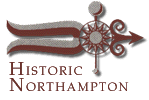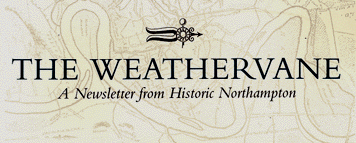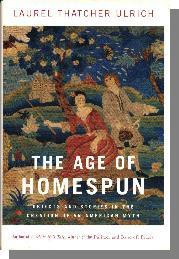

|


Weathervane Newsletter Summer 2002

Book Review: The Fabric of History
Laurel Thatcher Ulrich, The Age of Homespun: Objects and Stories in the Creation of an America Myth (New York: Alfred A. Knopf, 2001)
In 1851, Horace Bushnell spoke on the occasion of Litchfield, Connecticut's centennial celebration. His talk, which recalled the thrift, industry, piety and dignity of the town's eighteenth-century forebears, was titled the "Age of Homespun." The phrase stuck: in the 150+ years since Bushnell coined it, Americans have embraced the intellectual haven it offers, looking lovingly, even wistfully, back to an era when women and spinning wheels seemed almost synonymous, before market forces invaded village life, before rural virtue was threatened by the vices of modern society.
In The Age of Homespun: Objects and Stories in the Creation of an America Myth, Laurel Thatcher Ulrich, Phillips Professor of Early American History at Harvard University, explores not just the ways in which textiles functioned in early America, but also how people have remembered them, and what both might tell us about the changing shape of American life. This book, the author tells us, is about both the production of cloth, and the production of history. Throughout her career, Ulrich has nurtured a long interest not just in the facts of the past, but the way subsequent generations have interpreted those facts. Her first book, Good Wives: Image and Reality in the Lives of Women in Northern New England, 1650-1750 (1982) explored both the image and reality of early American women's lives, and A Midwife's Tale: The Life of Martha Ballard Based on Her Diary, 1785-1812 (1991) pauses to consider what Ballard's diary may have meant to her descendents. In Age of Homespun, those interests gain their fullest expression to date, as Ulrich hopes to plumb not just what the objects have to teach us about the past, but also how their very preservation in museum collections can be instructive, too, as sources of insight into how intervening generations of Americans helped shape the historical memory that we inherit today.
Each chapter, then, begins with an object: an indian basket, spinning wheels, a chimneypiece, a cupboard, a niddy-noddy, bed coverings, silk embroidery, a pocketbook, a linen tablecloth, a coverlet and rose blanket, and an unfinished knit stocking. Close study of each allows Ulrich to range widely through histories of early Americans that may or may not be related to her original subject. The objects serve as points of departure, and depart she does, into discussions of Algonkian-Anglo commerce, warfare, and marriage, the textile industry in the early modern Atlantic world, gender, culture and property, premarital pregnancy, slavery and abolitionism, imperial and colonial politics, industrialization, and a host of other topics, including the events and motivations that accompanied the objects' survival into the present century. Textile arts may provide the lens through which those subjects are observed, but the result is a tremendously learned and sweeping survey of American societies, economies, and cultures from the late seventeenth to the early twentieth century.
It is Ulrich's wonderfully tactile style that makes this such an engrossing and satisfying read. At one point, trying to help readers understand spinning, she sends readers to the medicine cabinet in search of those ubiquitous balls of cotton, and then explains how to manipulate the material to gain a better understanding of cotton thread. It is that gift, the ability to make tangible hazy scenes of the past, that has endeared the author to thousands of readers. No one is a keener observer of early American artifacts than Laurel Ulrich, and few can match her graceful prose. She brings a sure and loving hand to the stuff of history, and that alone makes this book worth the price of admission.
Dr. Miller teaches history at the University of Massachusetts where she is Director of the Public History Program.
Contents Historic Northampton.